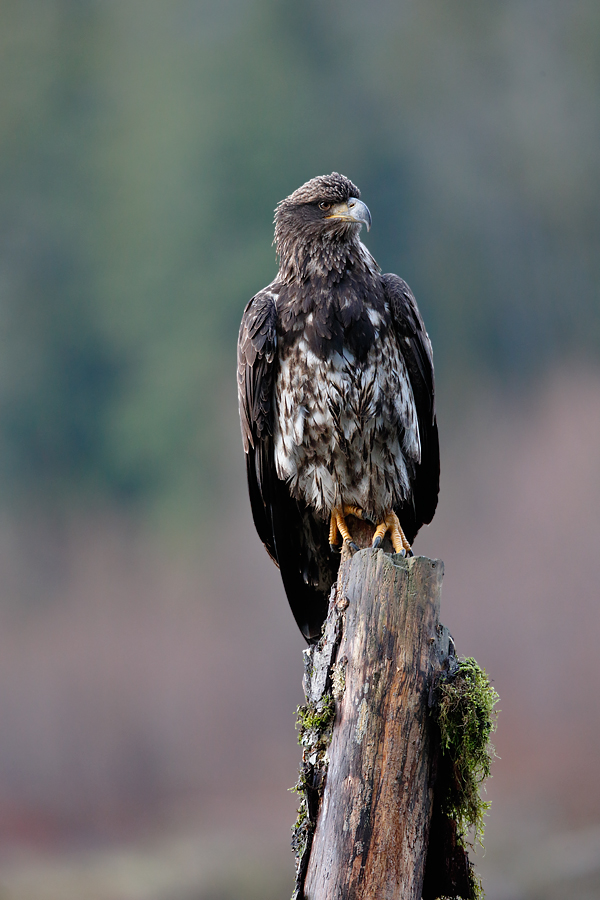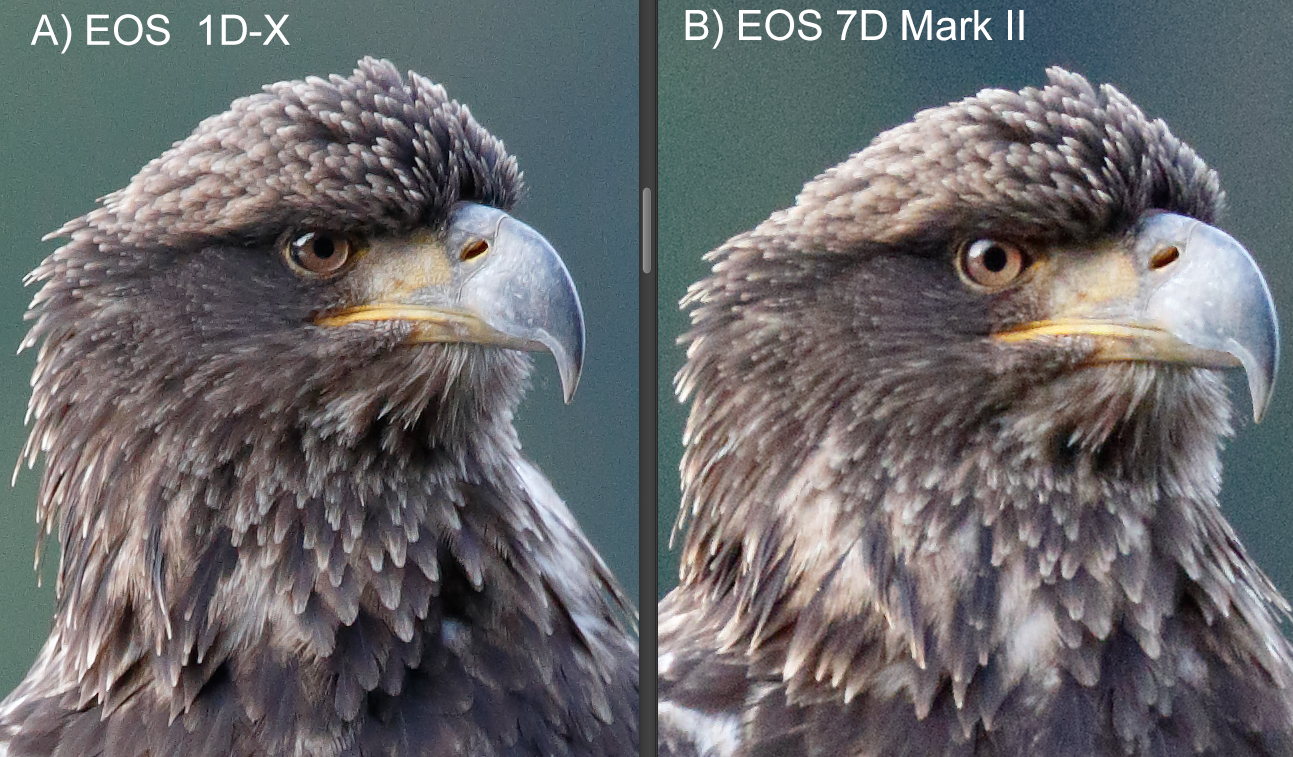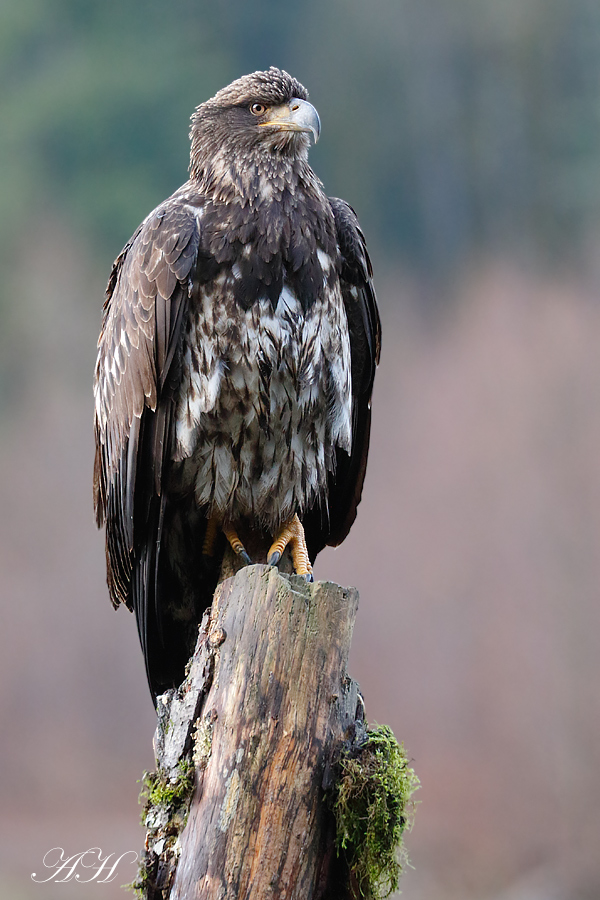
Bald eagles and first impressions on the 7D2 + 100-400 L II
It finally stopped raining today and I had a chance to photograph bald eagles today with my friend Henrik Nilson in Vancouver, B.C. area. We had overcast skies but fortunately the morning fog burned off quickly. Courtesy of Henrik, I got to try the new EF 100-400 IS II (mine didn’t arrive in time for my trip) and the EOS 7D Mark II. A small-sensor camera usually doesn’t fit my shooting style and my image quality expectations, but nevertheless this would have been a situation where I would prefer a light setup given the travel restrictions. We were short of light, time and space so I thought this would be a good situation to see whether the new 7D2 can deliver what is expected from it in a challenging real world situation rather than in the comfort of a warm living room where light is controlled by a switch.
I was using my main travel rig which is the 1DX plus the EF 300mm f/2.8 IS II. Attached to the 300 II was the 2X Extender III which is not only tack sharp but it also focuses blazingly fast even in very dim conditions. Henrik’s brand new EOS 7D MK II was mated with the new EF 100-400 f/5.6 L II, a lens that is most attractive to the target market of the 7D MK II and is very versatile for traveling.
The EF 100-400 IS II felt very solid in my hands, the build quality was superb. The zoom mechanism is much better than the awkward pull-push design of the old zoom. The zoom ring itself, is smooth without any play or creep, and of course, it can be locked. IS was very effective and the AF drive was fast, it felt faster than the EF 400 f/5.6L which itself was faster than the old EF 100-400 L IS. In my opinion, this lens replaces not only the old EF 100-400 L IS, but also the EF 400 f/5.6 L, the EF 300 f/4 L IS as well as the EF 70-300 L IS.
The EOS 7D Mark II also felt right in my hands, the grip is a bit small but that is probably because I am used to the deep grip of the 1D series. The finder was small and the exposure meter was difficult to see compared to the 5D or the 1D series. Against this feather-weight combo, was the EOS 1D-X paired to the EF 300 F/2.8L IS II and the 2X Extender III which also felt pretty light in my hands that are used to holding a 600 II rig all day long. needless to mention, both rigs were used hand held.
When looking through the finder of the EOS 7D MK II, it seemed the focus had locked with no issues, but when inspecting the RAW files unfortunately most of them were soft with only a few tack sharp files in between. This was surprising given that this rig was lighter than the 1DX combo. Given this I didn’t have confidence to proceed and try the EOS 7D Mark II for flying eagles in low light, fearing it would miss the few opportunities we had.
Test subject, shown below, was a juvenile bald eagle perched at close range.

Juvenile Bald Eagle. EOS 1D-X with EF 300mm f/2.8 IS II. ISO 3200, f/5.6 at 1/640 sec. Hand Held. Processed with DPP 4.
The example below illustrates the soft focus issue that I experienced. It seemed like the servo focus was not fully stable when locked on a subject with little if any movement.

100% crop from RAW. images 1 and 2 are two consecutive frames in a burst. Image 1 is noticeably sharper than 2. EOS 7D Mark II, EF 100-400 L IS II at 400mm. ISO 3200, f/5.6 at 1/640sec. hand held. Click on the image to expand.
This reminded me of the original EOS 7D which had the same issue. I had planned to evaluate the EOS 7D Mark II in more detail for flight photography but given my initial impression about AF, I have decided to defer judgement to a later date when it is certain that the AF system has no defects. The EOS 1D-X as well as Henrik’s EOS 5D Mark III had no issue shooting with the same maximum aperture of f/5.6. The result from these two bodies, plus the close shooting distance would also rule out heat refraction effects at the time of the test.
After downloading the RAW files, I put the sharpest file from the EOS 7D Mark II side-by-side to a file from the 1DX. Both files were shot from the same distance at ISO 3200, f/5.6 at 1/640 sec, hand held. The EOS 1DX had the EF 300 f/2.8 II IS with the Extender 2X III (600mm) while the EF 100-400 IS II was set to 400mm on the EOS 7D Mark II to give approximately the same field of view (FOV). This resulted in a full frame portrait of the juvenile bald eagle in each camera. I chose to use such setup because this is how I would use each camera to photograph the scene. Below is the 100% output from RAW converted with optimal settings in DPP4. Eagle moved just a bit between the two shots, please excuse him.

100% crop from RAW, converted with DPP 4.15. A) EOS 1D-X, EF 300mm f/2.8 IS II, EF Extender 2X III. ISO 3200, f/5.6 at 1/640sec. Hand held. B) EOS 7D Mark II, EF 100-400 L IS II at 400mm, ISO 3200. f/5.6 1/640sec. Hand held.
The difference is quite striking, as you can see the 7D Mark II is quite soft. Having said that the EOS 1D-X combo weighs about 9.3 lbs while the EOS 7D Mark II weighs about 5.6 lbs and it also costs significantly less. Is it worth it? For me, yes. I like to travel for photography and shoot different birds in their natural habitat, this means shooting conditions that are totally out of my control. Recently I have frequently found myself under overcast skies, shooting skittish raptors with only few opportunities. When the opportunity comes, I cannot miss because there is no second chance or all the time and $$$ spent on the trip will be wasted. So it all depends on your expectations and goals.
One good news is that Canon’s own DPP 4 does a very good job of cleaning the rather grainy files of the EOS 7D Mark II and extract every bit of detail. Below is the same example above, after processing with DPP, resize in Photoshop and output sharpening.

Juvenile Bald Eagle. EOS 7D Mark II, EF 100-400 L IS II. ISO 3200, f/5.6 at 1/640sec. Hand held. Gear courtesy of Henrik Nilson.
As you can see, after processing (for details see my DPP 4 Guide), noise reductions and sharpening, there is little difference between the small size output from both cameras. Of course larger files, cropping tighter or a large print will expose the differences, but if all you need is a small file for internet display the EOS 7D Mark II isn’t bad, especially when compared to the old 7D which couldn’t produce anything usable at this ISO even at small size.
Hi Ari
I am a rather novice avian photographer from Finland. Have been using 5 D III for two years and before that 7D. I sold my 7D which was my second body to buy 7D II. I maybe have had similar issues that you describe above with my setup (EF 300 f/2.8 II IS with the Extender 2X III) with the new camera compared to 5D III. It is still hard to tell, because here in Finland it is rather dark this time of the year.
I am using your guides and my question deals with the DPP 4 guide. I wonder if you could add the noise reduction and sharpening figures for the 7D II as well, even though I don`t know yet, is it going to be my main body for bird photography.
Best regards
Juha Vesaoja
Helsinki, Finland
H Juha,
we have updated the guide with 7D2 values, please email me so I can send you the updated version
I have the DPP 4 guide, if there are updates for the 7D 2 I would appreciate being able to get them also. Mike
Hi Mike, If your guide doesn’t have recommended parameters for the 7D2 please email me and I’ll send you the updated version.
So, if I purcfase the AF guide today it will include the 7D2 updates? Or are those a separate file you need to send me? Thanks for your review above, I want to maximize my output from the 7D2 and 100-400 II COMBO.
Hi Jo, right now the AF guide does not include 7D Mark II specifically . Given my experience, I don’t yet have full confidence in the system but I would recommend the same parameters used for the 5D3 as the two systems are similar. I plan to re-evalaute the system after a possible firmware update or if it becomes evident that this issue is isolated to some bodies or fixed in the later bodies. My friend and great flight photographer, Douglas Brown has also observed this issue, so I trust my finding is valid.
best
Have you done any tests between the 1dx and 7d mark II with the same lens, same distance, cropped accordingly? If so, were there still focus issues with the 7DM2? How do noise levels compare in this scenario in which the 1DX would require heavier cropping compared to the 7DM2 at fixed distance?
Hi Alan, this shoot was done from the same distance but I didn’t have time to swap the lenses.
Best
You were shooting with a bad copy of the 7DMKII. No point drawing conclusions until you have a good copy. My first copy produced results just like what you have posted. My second copy produces tack sharp images like your 1DX. I suspect the Canon QC is a little less than it should be for their cheaper bodies.
Buying a camera is not a lottery, the median sample should be good enough not just the 3 sigma tail. I yet have to see a file that I call “tack sharp” for a 7D2, but I am more critical than an average photographer.
I once owned a 7D and had the same issue with soft images. I now own a 5DMKIII and images are way better and “Tack Sharp”. Seems like the 7DIII still has the same issue.
Hello Ari,
My question does not directly relate to the issue you are discussing. I wonder if you could comment on the sharpness of EF100-400mm II vs I at 400 mm? Have you had any chance to compare them? I have looked at the comparison between the two lenses on thedigitalpicture.com and don’t see any difference at 400mm based on the two tested samples. At the same time there is much excitement about the sharpness of the new version. Unfortunately, I yet to find any real life comparison pictures between the two versions. Any comments would be appreciated.
Regards,
Amir
Hi Amir,
The new lens is MUCH sharper than the old one at all focal lengths. The old lens never met my standards for avian photography thus I did not use or recommend it, but I would use the new lens without hesitation.
best
Hello Ari,
May you please share the updates for the 7D 2
Thanks
Kishu
Hi Kishu,
After trying two more bodies my impression remains unchanged.
Comparing 1dx vs 7d mark ii at iso 3200 is not a good sharpness test. 7d mark ii at iso 3200 will be more noisy than 1dx. You should have had them both at iso max 400 to compare the cameras. 1dx will always produce sharper images that 7d mark ii at those iso as it is a full frame camera.
Hi Andrews, that’s not true. Noise and focus are two different metrics. A noisy photo can still be sharply focused, but this wasn’t the case with the 7D2. Of course if you are not careful with RAW conversion and apply strong noise reduction that will make the high ISO file look softer, but that was not the case here.
best
Hi. I have the original 7D and i want to upgrade to new camera to give better auto focus and IQ. What do you recommend between 7D MII or 5D MIII? And for one used to the crop sensor. Is the full frame sensor will be an issue? I mean for cropping, the APSC has a 1.6 crop factor. Thank you.
It depends on your lens.
Ari
Andrew has a point. It is widely accepted that the APS-C cameras do not have as good a noise performance as FF. I have not had good results at ISO1600 and above on my APS-C body, and only use this or higher ISO where the alternative is “no picture”. Because of the smaller pixel size it is also more sensitive to camera shake than FF, perhaps even focus too, and I would say that this actually makes getting good results from crop harder than on FF. My conclusion is that a better comparison might be to limit the ISO to 800 on FF and 400 on crop. Other than these provisos, it is possible to obtain sharp images on crop, but I can see that professionals will want faster, noise-free performance and will stick with 5D’s or 1D’s.
John,
It’s true that the image is noisier but it is also softly focused. I have sharp files with the 7D2 at ISO 3200 and 1600 but as I mention the performance isn’t consistent unfortunately.
I do have a new copy of the 7D2 that’s somewhat better than the early production ones, but still not quite up to my standards…
best
Interesting comparison.
I have some questions concerning the new 100-400 L II f4.5-5.6 is usm, since I have the old version of this lens, that I use with a 1d mark IV.
– Did you notice any substantial difference in focus speed/focus accuracy/focus precision, comparing the 100-400 II with the previous version?
– On the 1d mark IV (probably with the more recent cameras, like the 1dx, the problem is less noticeable), if the 100-400 mk1 is paired with an extender 1.4x III the focus speed decreases quite substantially, and also the focus tracking performances (in terms of precision and accuracy) are affected.
Do you think that with the 100-400 II there would be a significant improvement, under this point of view?
Thank you.
Hi Matteo, I didn’t use the original EF 100-400 as it did not meet my expectations in terms of sharpness. I don’t have a 1D MK IV (I sold my MK4 bodies 5 years ago when 1DX came out) but that camera doesn’t have the new AF system so it will most likely slow down with the TC added
best
[…] APS-C cameras partly due to bad taste left from the poor performance of the Canon 7D series. (read my impressions of the 7D Mark II here published several years ago). So until 2019 I had not shoot extensively with […]